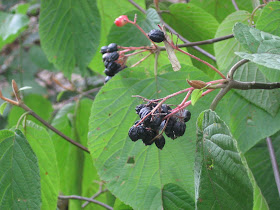
When describing our project to Ben's uncle, he asked, "So has any plant actually gotten a 5? Or are you just eating lots of nearly inedible plants?" He was skeptical that wild food could be yummy. We knew it could, but even we are amazed at how many 4s and 5s we discovered!
46. Lamb's Quarters: use like spinach, versatile and common: 4
47. Common Plantain: tough, cook well, hide in other foods: 2
48. Milk Weed flowers: hard little balls, easy to cook, nice change from greens, we threw them in a savory pancake batter: 4
49. Ox-eye Daisy leaves: A little spicy, the basal leaves are sweeter and easier to gather than the stem leaves, we made it into a tabouli: 4
50. Red Clover flowers: sweet, easy to identify and collect, we made vinegar, iced tea, and attempted syrup, the baby loves them and sucks on them all the time: 4
51. Wild Lettuce: we cooked it well and put it in quesadillas, we have since learned that we ate the most bitter of the wild lettuces and reserve judgement until we try others: ?
52. Wild Strawberries: small, sweet, and succulent: 4
53. Purslane: how did we not discover this great salad green earlier? So mild and tender, we are encouraging the weeds in our herb garden: 5
54. Day Lily buds: A great vegetable, easy to use in a variety of ways: 5
55. Cattail Spikes: We ate them like corn on the cob, sweet and fun, the baby loved them: 5
56. Red Raspberry: no description necessary: 5
57. Black Rasberry: around here even sweeter than red raspberry, but scarcer: 5
58. Crayfish: Our first animal, sweet and mild like lobster, but with a texture more like crab: 4
59. Blackberry: A fantastic year for blackberries! : 5
60. High bush blueberry: 5
61. Low bush blueberry: even sweeter than high bush, but harder to gather: 5
62. Huckleberry: hard little seeds, but otherwise tastes like blueberries: 5
63. Day Lily flowers: superior taste, the best flower I've tasted, but eat in moderation: 5
64. Sumac flowers: tangy and sweet, make into a lemondade: 5
65. Dewberry: much like blackberry, but grow low along the ground: 5
66. Basswood nut: we ate them too soon, but they were sweet and soft, we will keep trying: ?
67. Goose Tongue greens: salty and yummy, they didn't turn out as well when we prepared them ourselves, see post for more info: 3
68. Elder flower: our good friend Rebecca made a mead with them last year. It was fantastic, and I generally don't like alcohol at all. I will make it next year. Rating is difficult. The mead was a 5, but I'm not sure how to rate the flowers themselves.
69. Chanterelles: Not a good year here for most mushrooms. Too little rain. We cooked up three little chanterelles and they were fantastic: 5
70. Black Stain Polypore: Ben collected with Arena. She called later and told us she felt they were not good. We had already eaten them. They had a strong smell and a distinctly meat like flavor. Not unpleasant, and our reading has confirmed that this is a common description. Would like more info and to try again: 3
71: Berkley's Polypore: Tastes like oysters: 4
72: Mulberry: Looks like blackberry, but much tangier: 5
73: Milk Weed pods: The insides prepared alone are sweet and mild, the buds whole are supposedly similar, but ours were clearly bitter: we need to do more research
It is kind of exciting to write this post. Here we are--mid summer--more than half way to our goal. Summer has presented so many new plants to us. At this point, it could be easy to get a little cocky. However, we've spent as much time recently reading about and identifying plants we will gather this fall as we have gathering the current harvest. This preparation has been a little intimidating. Many of the fall plants are plants we've never eaten and require much preparation as well as some trips outside our immediate gathering area. But we are excited about the adventure.
 The movie Julie and Julia inspired us to create this blog. Like Julie, we wanted a life raft that would sustain our passions in a world seem bent on drowning them. In the film, Julie's final recipe was prepared as a feast to celebrate her success with a few close friends. To continue the metaphor, her life raft had come to rest on a hospitable shore. And so has ours. We thought it fitting to close our wild edible adventures this year with a feast shared with our foraging friends. Arena came, and so did Ben and Rebecca. The foragers that we knew best would finally meet. Ooga and I found ourselves hoping that they would all hit it off.
The movie Julie and Julia inspired us to create this blog. Like Julie, we wanted a life raft that would sustain our passions in a world seem bent on drowning them. In the film, Julie's final recipe was prepared as a feast to celebrate her success with a few close friends. To continue the metaphor, her life raft had come to rest on a hospitable shore. And so has ours. We thought it fitting to close our wild edible adventures this year with a feast shared with our foraging friends. Arena came, and so did Ben and Rebecca. The foragers that we knew best would finally meet. Ooga and I found ourselves hoping that they would all hit it off.
 Our friends left well fed. We shared our stories of the past season and dreamed of the next. It was the last scene of our movie.
Our friends left well fed. We shared our stories of the past season and dreamed of the next. It was the last scene of our movie.














































